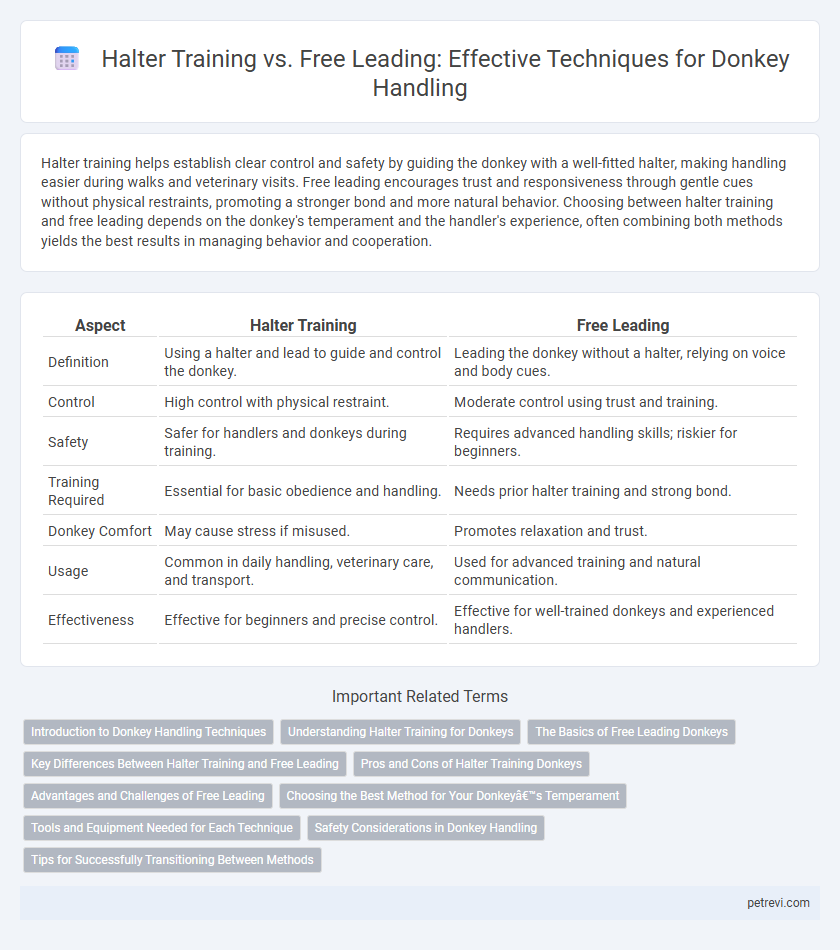Halter training helps establish clear control and safety by guiding the donkey with a well-fitted halter, making handling easier during walks and veterinary visits. Free leading encourages trust and responsiveness through gentle cues without physical restraints, promoting a stronger bond and more natural behavior. Choosing between halter training and free leading depends on the donkey's temperament and the handler's experience, often combining both methods yields the best results in managing behavior and cooperation.
Table of Comparison
| Aspect | Halter Training | Free Leading |
|---|---|---|
| Definition | Using a halter and lead to guide and control the donkey. | Leading the donkey without a halter, relying on voice and body cues. |
| Control | High control with physical restraint. | Moderate control using trust and training. |
| Safety | Safer for handlers and donkeys during training. | Requires advanced handling skills; riskier for beginners. |
| Training Required | Essential for basic obedience and handling. | Needs prior halter training and strong bond. |
| Donkey Comfort | May cause stress if misused. | Promotes relaxation and trust. |
| Usage | Common in daily handling, veterinary care, and transport. | Used for advanced training and natural communication. |
| Effectiveness | Effective for beginners and precise control. | Effective for well-trained donkeys and experienced handlers. |
Introduction to Donkey Handling Techniques
Halter training establishes control by teaching donkeys to respond to pressure on a halter, enhancing safety and communication during handling. Free leading involves guiding donkeys without physical restraints, promoting trust and cooperation through body language and cues. Both techniques are essential for effective donkey handling, as they develop responsiveness and mutual respect between handler and animal.
Understanding Halter Training for Donkeys
Halter training for donkeys establishes essential control and communication by introducing a soft, adjustable halter that fits comfortably around the donkey's head. This method encourages trust and responsiveness through gentle guidance, enabling handlers to lead donkeys safely during grooming, veterinary care, and transport. Consistent halter training improves the donkey's cooperation and reduces stress, making everyday handling more effective compared to free leading, which relies on the donkey's voluntary movement without physical restraint.
The Basics of Free Leading Donkeys
Free leading donkeys involves training them to follow handler cues without physical restraint, promoting trust and natural communication. This technique emphasizes consistent voice commands and body language to guide donkeys calmly and responsively. Mastering free leading enhances donkey cooperation, making handling safer and more enjoyable.
Key Differences Between Halter Training and Free Leading
Halter training involves using a physical halter to guide and control the donkey, providing clear cues and restraint, which is essential for precision and safety during initial handling or unfamiliar environments. Free leading relies on voice commands and body language, fostering trust and responsiveness without physical restraint, ideal for advanced training and building a strong handler-donkey relationship. Key differences include the level of physical control, communication methods, and the training goals--halter training prioritizes control and obedience, while free leading emphasizes cooperation and mutual understanding.
Pros and Cons of Halter Training Donkeys
Halter training donkeys offers precise control and easier management during grooming, veterinary care, and transportation, improving safety for both the handler and the animal. However, excessive halter use can cause discomfort or stress in donkeys, potentially leading to resistance or behavioral issues if not introduced gradually. Balancing consistent halter training with positive reinforcement helps maintain trust and ensures effective handling without compromising the donkey's well-being.
Advantages and Challenges of Free Leading
Free leading in donkey handling fosters natural trust and communication by allowing the donkey to move without restraint, enhancing their willingness to follow voluntarily. This method reduces stress and physical discomfort often caused by halters but requires consistent, patient training to ensure safety and responsiveness. Challenges include the need for a controlled environment and the handler's skill in reading the donkey's behavior to prevent sudden flight responses.
Choosing the Best Method for Your Donkey’s Temperament
Choosing the best method for donkey handling depends heavily on the individual donkey's temperament, with halter training offering structured control for more stubborn or less socialized donkeys. Free leading promotes trust and cooperation, ideal for gentle or well-mannered donkeys that respond positively to loose guidance. Understanding your donkey's behavior and stress signals ensures effective training, enhancing safety and bonding during handling sessions.
Tools and Equipment Needed for Each Technique
Halter training requires a properly fitted halter made of durable materials like leather or nylon, along with a lead rope typically measuring 6 to 8 feet for controlled guidance. Free leading relies minimally on equipment, often just a lightweight halter or neck collar, allowing the donkey to follow voluntarily without physical restraint. Both techniques benefit from the use of treats or clickers to reinforce positive behavior during handling sessions.
Safety Considerations in Donkey Handling
Halter training provides greater control over donkeys, minimizing risks of sudden movements that can cause injury to handlers. Free leading allows more natural movement but requires experienced handling to ensure the donkey responds safely to commands without a physical restraint. Prioritizing secure, well-fitted equipment and consistent training routines significantly enhances safety in both halter training and free leading contexts.
Tips for Successfully Transitioning Between Methods
Effective halter training establishes a foundation of trust and control, crucial for transitioning donkeys to free leading by emphasizing consistent, gentle pressure and release techniques. Gradual exposure to free leading environments combined with positive reinforcement encourages donkeys to respond calmly without physical restraints. Monitoring body language and patience during each step safeguards against stress, ensuring a smooth shift between handling methods.
Halter Training vs Free Leading for Donkey Handling Infographic

 petrevi.com
petrevi.com